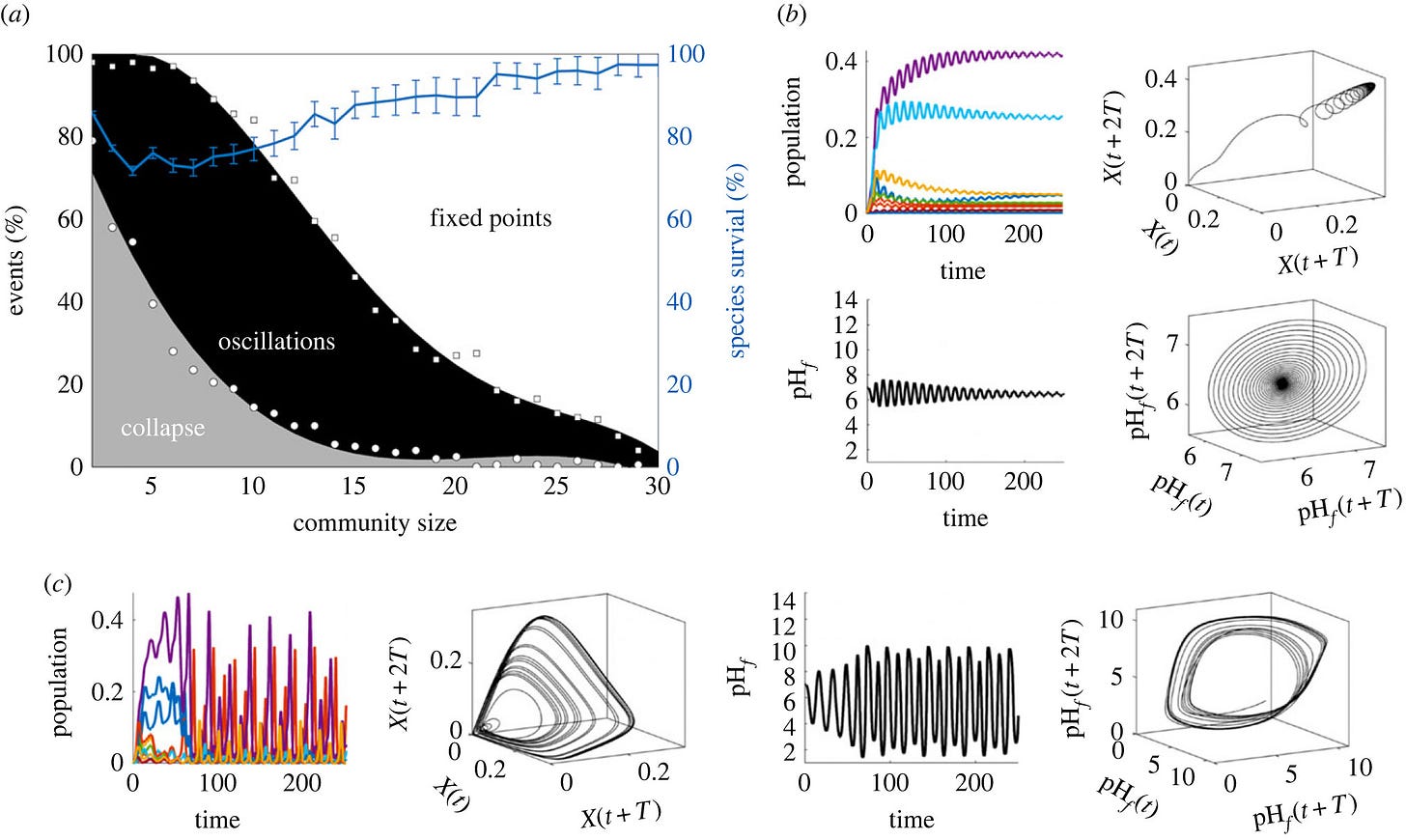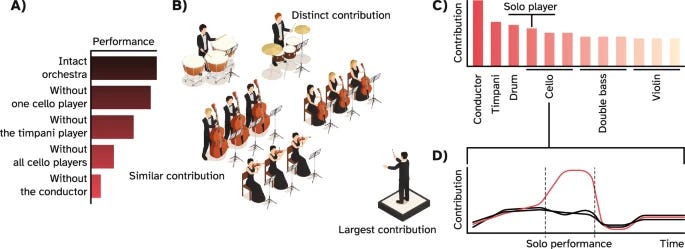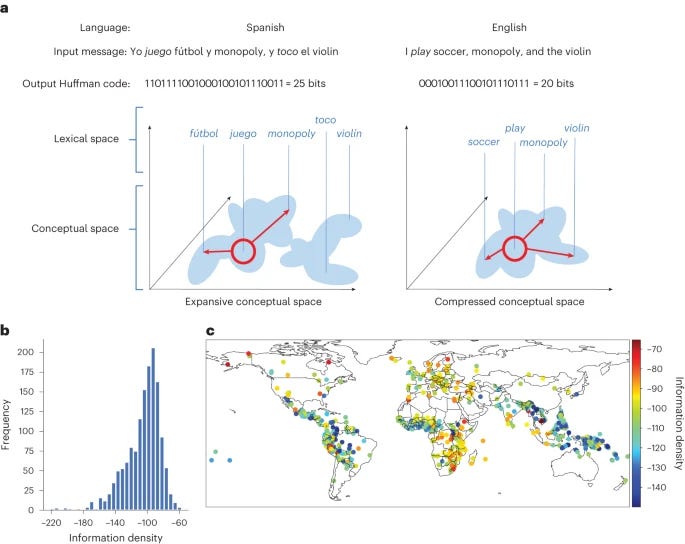If you find Complexity Thoughts interesting, follow us! Click on the Like button, leave a comment, repost on Substack or share this post. It is the only feedback I can have for this free service. The frequency and quality of this newsletter relies on social interactions. Thank you!
Dall-e 3 representation of this issue’s content
Foundations of network science and complex systems
Maximal Diversity and Zipf’s Law
Zipf’s law describes the empirical size distribution of the components of many systems in natural and social sciences and humanities. We show, by solving a statistical model, that Zipf’s law co-occurs with the maximization of the diversity of the component sizes. The law ruling the increase of such diversity with the total dimension of the system is derived and its relation with Heaps’s law is discussed. As an example, we show that our analytical results compare very well with linguistics and population datasets.
Idea engines: Unifying innovation & obsolescence from markets & genetic evolution to science
As usual, it is rather complicated to just give a label to papers in complexity science, since, often, they are covering more than just a specific aspect.
This is the case of this paper, that is surely related to evolution and ecosystems (broadly speaking), but its ground is on physics. Therefore, to my eyes, it is more relevant for this section than others.
Innovation and obsolescence describe dynamics of ever-churning and adapting social and biological systems, concepts that encompass field-specific formulations. We formalize the connection with a reduced model of the dynamics of the “space of the possible” (e.g., technologies, mutations, theories) to which agents (e.g., firms, organisms, scientists) couple as they grow, die, and replicate. We predict three regimes: The space is finite, ever growing, or a Schumpeterian dystopia in which obsolescence drives the system to collapse. We reveal a critical boundary at which the space of the possible fluctuates dramatically in size, displaying recurrent periods of minimal and of veritable diversity. When the space is finite, corresponding to physically realizable systems, we find surprising structure. This structure predicts a taxonomy for the density of agents near and away from the innovative frontier that we compare with distributions of firm productivity, COVID diversity, and citation rates for scientific publications. Our minimal model derived from first principles aligns with empirical examples, implying a follow-the-leader dynamic in firm cost efficiency and biological evolution, whereas scientific progress reflects consensus that waits on old ideas to go obsolete. Our theory introduces a fresh and empirically testable framework for unifying innovation and obsolescence across fields.
I liked the attempt to falsify the model by means of a diverse set of empirical data, as show in the figure below. There is no explicit definition in the paper, so I try to infer what the authors mean for the following innovation models:
Schumpeterian innovation: the concept of creative destruction referring to the process by which the old economic structures and industries are continually destroyed and replaced by new ones. It is a core mechanism in the dynamics of capitalism, emphasizing how innovation drives the obsolescence of existing technologies, products, and business models, leading to economic evolution and growth.
Darwinian innovation: in biology, it relates to the evolutionary process through which organisms adapt and evolve over time. It relies on natural selection, where genetic variations that confer an advantage in survival and reproduction are more likely to be passed on to subsequent generations.
Socratic innovation: I never heard about it in this terms, but it should refer to an approach that emphasizes questioning, dialogue, and critical examination, akin to the Socratic method. Here innovation is driven by an iterative process of questioning existing knowledge and exploring new ideas, which can lead to novel inventions (e.g., theories and experiments) and discoveries. This is approach fosters cumulative and collaborative advancement in science and technology.
Empirical vs. model predictions for innovativeness pseudogaps in (A and D) firms, (B) genetic mutations, and (C and G) scientific citations. Data are in color, and model fits are dashed black lines. Histogram for (A) U.S. metal stamping industry with model fit (black) to the year 1958 (11) and (D) cross-industry Indian firms grouped by size (38). (B) SARS-CoV-2 diversity by number of base pair mutations from first detected strain hCoV-19/Wuhan/Hu-1/2019 normalized by branching rate (39, 40). Model overpredicts occupancy number near the origin, implying variants were missed by limited surveillance at the beginning of the pandemic (41). (C) Normalized citation rate for Physical Review B articles published in 1980 and separated by total citations as of 2020. (G) Normalized citation rates for patent applications in electrical and electronic technologies filed in 1990 and granted before 2022 separated by total citations within 20 y of filing (42). Sharp Einsteinian innovation events change the very parameters of innovation such as with (E) the emergence of strains in the Delta clade and (F) fast mutator strain in long-term E. Coli experiments where starred (43).
Ecosystems
A synthetic microbial Daisyworld: planetary regulation in the test tube
In the 80s, Lovelock and Watson proposed a hypothetical planet simulation to illustrate the Gaia hypothesis, suggesting that life and the Earth's environment are closely integrated, forming a self-regulating system. In their Daisyworld model, the planet's surface is populated only by two types of daisies: black and white. The black daisies absorb more sunlight and thus are warmer, while the white daisies reflect sunlight and are cooler. As the planet's temperature changes, it affects the daisies' growth, which in turn influences the planet's albedo (reflectivity) and thus its temperature.
The model demonstrates how a life-environment feedback loop can lead to a form of self-regulation. Even as the luminosity of the planet's sun changes, the biological processes of the daisies can maintain the planet's temperature within a range conducive to life. This simple model provided a ground for Earth systems science, showing how living organisms can interact with and stabilize their environment, even if in a highly idealized and simplified way.
Ever wondered about creating a synthetic microbial Daisyworld to test the hypothesis beyond simulations? Here you go.
The idea that the Earth system self-regulates in a habitable state was proposed in the 1970s by James Lovelock, who conjectured that life plays a self-regulatory role on a planetary-level scale. A formal approach to such hypothesis was presented afterwards under a toy model known as the Daisyworld. The model showed how such life-geosphere homeostasis was an emergent property of the system, where two species with different properties adjusted their populations to the changing external environment. So far, this ideal world exists only as a mathematical or computational construct, but it would be desirable to have a real, biological implementation of Lovelock’s picture beyond our one biosphere. Inspired by the exploration of synthetic ecosystems using genetic engineering and recent cell factory designs, here we propose a possible implementation for a microbial Daisyworld. This includes: (i) an explicit proposal for an engineered design of a two-strain consortia, using pH as the external, abiotic control parameter and (ii) several theoretical and computational case studies including two, three and multiple species assemblies. The special alternative implementations and their implications in other synthetic biology scenarios, including ecosystem engineering, are outlined.
Predation and spatial connectivity interact to shape ecosystem resilience to an ongoing regime shift
Ecosystem regime shifts can have severe ecological and economic consequences, making it a top priority to understand how to make systems more resilient. Theory predicts that spatial connectivity and the local environment interact to shape resilience, but empirical studies are scarce. Here, we use >7000 fish samplings from the Baltic Sea coast to test this prediction in an ongoing, spatially propagating shift in dominance from predatory fish to an opportunistic mesopredator, with cascading effects throughout the food web. After controlling for the influence of other drivers (including increasing mesopredator densities), we find that predatory fish habitat connectivity increases resilience to the shift, but only when densities of fish-eating top predators (seals, cormorants) are low. Resilience also increases with temperature, likely through boosted predatory fish growth and recruitment. These findings confirm theoretical predictions that spatial connectivity and the local environment can together shape resilience to regime shifts.
Synthetic Eco-Evolutionary Dynamics in Simple Molecular Environment
The understanding of eco-evolutionary dynamics, and in particular the mechanism of coexistence of species, is still fragmentary and in need of test bench model systems. To this aim we developed a variant of SELEX in-vitro selection to study the evolution of a population of ∼ 10^15 single-strand DNA oligonucleotide ‘individuals’. We begin with a seed of random sequences which we select via affinity capture from ∼ 10^12 DNA oligomers of fixed sequence (‘resources’) over which they compete. At each cycle (‘generation’), the ecosystem is replenished via PCR amplification of survivors. Massive parallel sequencing indicates that across generations the variety of sequences (‘species’) drastically decreases, while some of them become populous and dominate the ecosystem. The simplicity of our approach, in which survival is granted by hybridization, enables a quantitative investigation of fitness through a statistical analysis of binding energies. We find that the strength of individual-resource binding dominates the selection in the first generations, while inter and intra-individual interactions become important in later stages, in parallel with the emergence of prototypical forms of mutualism and parasitism.
Evolution and artificial life
Evolution provides a creative fount of complex and subtle adaptations that often surprise the scientists who discover them. However, the creativity of evolution is not limited to the natural world: Artificial organisms evolving in computational environments have also elicited surprise and wonder from the researchers studying them. The process of evolution is an algorithmic process that transcends the substrate in which it occurs. Indeed, many researchers in the field of digital evolution can provide examples of how their evolving algorithms and organisms have creatively subverted their expectations or intentions, exposed unrecognized bugs in their code, produced unexpectedly adaptations, or engaged in behaviors and outcomes, uncannily convergent with ones found in nature. Such stories routinely reveal surprise and creativity by evolution in these digital worlds, but they rarely fit into the standard scientific narrative. Instead they are often treated as mere obstacles to be overcome, rather than results that warrant study in their own right. Bugs are fixed, experiments are refocused, and one-off surprises are collapsed into a single data point. The stories themselves are traded among researchers through oral tradition, but that mode of information transmission is inefficient and prone to error and outright loss. Moreover, the fact that these stories tend to be shared only among practitioners means that many natural scientists do not realize how interesting and lifelike digital organisms are and how natural their evolution can be. To our knowledge, no collection of such anecdotes has been published before. This article is the crowd-sourced product of researchers in the fields of artificial life and evolutionary computation who have provided first-hand accounts of such cases. It thus serves as a written, fact-checked collection of scientifically important and even entertaining stories. In doing so we also present here substantial evidence that the existence and importance of evolutionary surprises extends beyond the natural world, and may indeed be a universal property of all complex evolving systems.
Neuroscience
Downstream network transformations dissociate neural activity from causal functional contributions
to what extent are recorded neural patterns causally informative of a produced behavior?
Neuroscientists rely on distributed spatio-temporal patterns of neural activity to understand how neural units contribute to cognitive functions and behavior. However, the extent to which neural activity reliably indicates a unit's causal contribution to the behavior is not well understood. To address this issue, we provide a systematic multi-site perturbation framework that captures time-varying causal contributions of elements to a collectively produced outcome. Applying our framework to intuitive toy examples and artificial neural networks revealed that recorded activity patterns of neural elements may not be generally informative of their causal contribution due to activity transformations within a network. Overall, our findings emphasize the limitations of inferring causal mechanisms from neural activities and offer a rigorous lesioning framework for elucidating causal neural contributions.
Human Behavior
Human languages vary widely in how they encode information within circumscribed semantic domains (for example, time, space, colour, human body parts and activities), but little is known about the global structure of semantic information and nothing about its relation to human communication. We first show that across a sample of ~1,000 languages, there is broad variation in how densely languages encode information into words. Second, we show that this language information density is associated with a denser configuration of semantic information. Finally, we trace the relationship between language information density and patterns of communication, showing that informationally denser languages tend towards faster communication but conceptually narrower conversations or expositions within which topics are discussed at greater depth. These results highlight an important source of variation across the human communicative channel, revealing that the structure of language shapes the nature and texture of human engagement, with consequences for human behaviour across levels of society.










